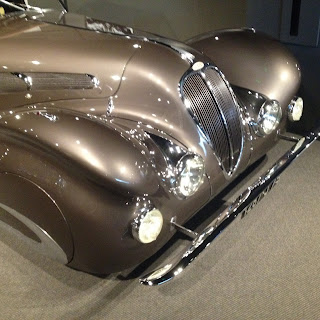Joseph Figoni, the designer of the Paris coach building duo that was Figoni and Falaschi, liked to trace sine waves in the air while telling customers, "I like the streamline." He did indeed, and after the mid-1930s his custom coachwork on bespoke chassis (often Delahaye and Talbot Lago) displayed an enthusiasm for the teardrop shapes which were then equated with aerodynamic efficiency. A series of roadsters and coupes showed the influence of auto racing fan and commercial illustrator Geo Ham, who often drew cars with fenders fully enveloping the front as well as rear wheels. Figoni's business partner Ovidio Falaschi brought in celebrity clients like Aly Kahn, who bought a Delahaye roadster in 1936. The wheel spats and sensuous curves were applied to our example car, a Delahaye Type 135 MS belonging to the Collier Collection at the Revs Institute, in 1937...
In keeping with Delahaye's Competition Special designation, the short chassis car (116 inch wheelbase) was bodied in aluminum, and weighed only 2,840 pounds. Compared with the engine designs at competitor Bugatti, and advanced chassis as well as engine designs at Alfa Romeo, the Delahaye* was fairly conservative. Unlike the twin overhead cam eights of these two competitors, the 135 MS featured a conventional, inline pushrod six with a cast iron block. It had independent front suspension, but a rigid rear axle. And unlike their sister cars in the combine that now included Delage, Delahayes delayed adoption of hydraulic brakes, favoring mechanical actuation until near the end, in the early 1950s. In the transmission department, Delahayes departed from convention with the Cotal electromagnetic transmission, a preselector unit not unlike that featured around the same time in the American Cord 810. As a result, the 135 MS offered four forward speeds, as well as four speeds in reverse…
The extravagant, voluptuous curves conceal time-honored, traditional construction methods. Metal bodies were hand-formed over wooden bucks, and wood framing was concealed below the bright metal surfaces. The visual sophistication easily outshone the engineering conservatism. Patented features of Joseph Figoni's invention included the folding top concealed under a metal cover, lightweight tubular seat frames, windshields which retracted into the cowl, and the famous compound curved fenders with spats concealing the wheels. These fenders must have been a real chore to form in alloy or steel, especially as Figoni was fond of adjusting lines and contours by a trial and error method, with the same casual attitude that a tailor might apply to altering a jacket. Note the way the designer superimposes the traditional clamshell fender form repeating the more open designs of the early 1930s over the fully enclosed teardrop around the front wheel, creating a complex concavity above the convex wheel spat, which is decorated with a bright chrome wave form repeated on the hood vents.
Unlike some designers who based their futurist arguments on the inevitable triumph of new technology (those at Lancia and Tatra come to mind), Joseph Figoni fashioned his exuberant visual statements over whatever engineering was readily (though expensively) available. His optimistic, four-wheeled metal poems still form a vivid contrast to the optimized, logical prose pieces built by contemporary engineers.
Photo Credits:
First 4 photos: Ian Avery-DeWitt
Bottom: the author
First 4 photos: Ian Avery-DeWitt
Bottom: the author





No comments:
Post a Comment